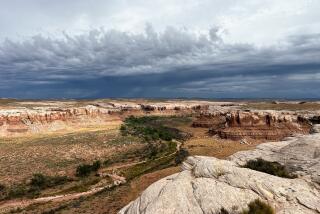U.S. aims to speed solar production
The Obama administration on Monday announced that it would put solar energy development in the West on a fast track, with Interior Secretary Ken Salazar signing an order that sets aside more than 1,000 square miles of public land for two years of study and environmental reviews.
Although the clean-energy initiative identifies some 676,000 acres of federal land for study, more than half -- 351,000 acres in the Mojave Desert -- are in California. According to maps released by the Interior Department, the solar project areas abut the border of Joshua Tree National Park, the Mojave Preserve and two national wildlife refuges in the southeastern part of the state.
The proposed California solar-generating areas are projected to have the annual capacity to produce 39,000 to 70,000 megawatts of electricity at full development -- enough to serve millions of homes. There are three large solar projects undergoing environmental review in the state.
President Obama has promised to promote the use of federal land for the production of alternative energy and has set a goal of obtaining 10% of the nation’s electricity from renewable sources by 2010. Salazar vowed to have 13 “commercial-scale” solar projects under construction by the end of 2010.
Federal land managers have already announced plans to establish areas of concentrated wind and geothermal energy harvesting. The Bureau of Land Management has gotten about 470 renewable energy project applications. Those include 158 active solar applications, covering 1.8 million acres.
Monday’s announcement in Las Vegas opens up land in six Western states to leasing by private companies. “We are putting a bull’s-eye on the development of solar energy on our public lands,” Salazar said.
Conservation groups reacted to the announcement with praise but cautioned that even so-called green projects could conflict with protected lands and sensitive species.
“We support the identification of the best places for renewable energy on public lands,” said Alex Daue of the Wilderness Society. “We can’t have a repeat of the oil and gas industry, where it’s spread wide across the landscape anywhere they want. We need a focused look at places where there’s the least conflict and highest opportunity for success.”
In California, the Mojave Desert is already the scene of intense interest from energy companies and a land rush to apply for solar leases. Environmentalists are monitoring maps so that leasing doesn’t take place in wilderness, areas of importance for wildlife and other resources, and high-value recreation sites. The Mojave is home to all of that, including national parks, threatened and endangered species and one of the West’s most popular off-road-vehicle recreation areas.
Salazar said federal agencies had already ruled out solar leasing on protected lands and would examine potential effects on wildlife before allowing projects to proceed. The two-year environmental study will cost $22 million, he said.
--
More to Read
Sign up for Essential California
The most important California stories and recommendations in your inbox every morning.
You may occasionally receive promotional content from the Los Angeles Times.











